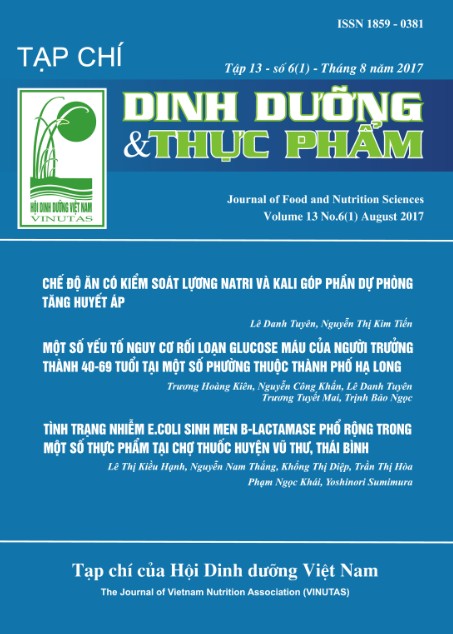ZINC DEFICIENCY STATUS AND RELATED FACTORS IN CHILDREN AGED 36-59 MONTHS WHO WERE STUNTED AND AT RISK OF STUNTING IN THANH LIEM DISTRICT, HA NAM PROVINCE, 2015
Main Article Content
Abstract
Malnutrition in combination with micronutrient deficiencies is very common, especially
zinc deficiency. A cross-sectional study was conducted among 501 children aged 36-59
months, who were stunted and at risk of stunting to determine zinc deficiency status and some
related factors. The result showed that the prevalence of zinc deficiency was 75.6%, at the
high level of public health significance. The mean serum zinc concentration was 8.7 ±1.9
μmol/L. The prevalence of zinc deficiency was similar in children aged 36-47 months (75.9%)
and 48-59 months (75.5%). Stunting and underweight increased the risk of zinc deficiency
2.1 times more compared to normal children (p <0.01). Serum zinc concentration in stunted
and underweight children was statistically significantly different from the normal children (p
<0.05). Linear multivariable regression showed that stunting was associated with serum zinc
concentration (p <0.01). Therefore, zinc deficiency is a serious public health problem in Thanh
Liem. In order to improve stunting status, there should be measures to address zinc deficiency
Keywords
Zinc deficiency, children under 5 year old, related factors, stunting
Article Details
References
2. Viện Dinh dưỡng (2015). Số liệu thống kê SDD trẻ em năm 2015. http://viendinhduong.vn/viewpdf.aspx?n=/2016/TL%20SDD%202015.pdf, 2016.
3. Claulfield LE, Black RE (2004). Zinc Deficiency. Comparative Quantification of Health Risks. Global and regional burden of disease attribution to selected major risk factors. World Health Organization,
2004: 257-279.
4. Laillou A, Pham TV, Tran NT, Le HT, Wieringa F, Rohner F et al (2012). Mi cronutrient deficits are still public health issues among women and young children in Vietnam. PLoS ONE 2012, 7, e34906. [CrossRef] [PubMed], 2012.
5. Viện Dinh dưỡng (2015). Đánh giá tình trạng thiếu máu, thiếu một số vi chất dinh dưỡng của phụ nữ và trẻ em 6 - 59 tháng tại vùng thành thị, nông thôn và miền núi năm 2014 - 2015. Báo cáo đề tài nghiên cứu cấp Viện 2015.
6. Engle-Stone R, Ndjebayi AO, Nankap M, Killilea DW, Brown KH (2014). Stunting prevalence, plasma zinc concentrations, and dietary zinc intakes in a nationally representative sample suggest a high risk of zinc deficiency among women and young children in Cameroon. The Journal of Nutrition. doi: 10.3945/jn.113.188383., 2014. 144(3): p. 382-91.
7. Nguyễn Xuân Ninh (2009). Cập nhật một số vấn đề về Chiến lược phòng chống thiếu vi chất dinh dưỡng. Tạp chí Dinh dưỡng và Thực phẩm, Tập 5 - số 3+4, 2009: p.23-29.
8. Lê Danh Tuyên, Lê Bạch Mai (2016). Nhu cầu Dinh dưỡng khuyến nghị cho người Việt Nam. Nhà xuất bản Y học, 2016.
9. Nguyen Van Nhien et al (2008). Micronutrient deficiencies and anemia among preschool children in rural Vietnam. Asia Pac J Clin Nutr,17(1), 2008: p.48-55.
10.Nguyễn Xuân Ninh và CS (2010). Đánh giá tình trạng thiếu vi chất dinh dưỡng tại 6 tỉnh miền núi phía Bắc, miền Trung và Tây Nguyên năm 2009, Báo cáo đề tài cấp Viện, 2010.
11.Wieringa FT, Dahl M, Chamnan C, Poirot E et al (2016). The High Prevalence of Anemia in Cambodian Children and Women Cannot Be Satisfactorily Explained by Nutritional Deficiencies or Hemoglobin Disorders. Nutrients. E348. doi: 10.3390/nu8060348, 2016. 8(348): 1-12.
12.IZINCG (2004). Assessment of the risk of zinc deficiency in populations and options for its control. Food Nutr Bull, 2004. 25(1):S187-S195.
13.Galetti V, Mitchikpè CE, Kujinga P, Tossou F, Hounhouigan DJ, Zimmermann MB, Moretti D. (2016). Rural Beninese Children Are at Risk of Zinc Deficiency According to Stunting Prevalence and Plasma Zinc Concentration but Not Dietary Zinc Intakes. The Journal of Nutrition. doi: 10.3945/jn.115.216606, 2016. 146(1): 114-23


